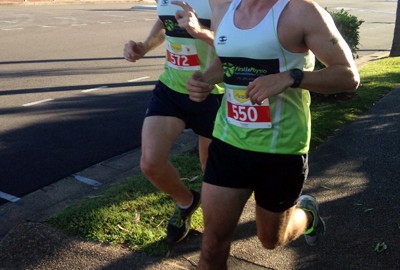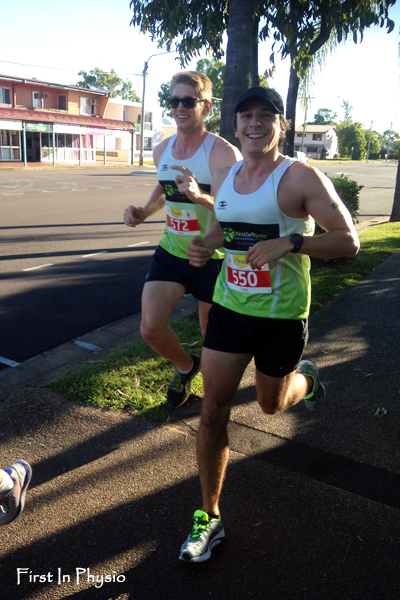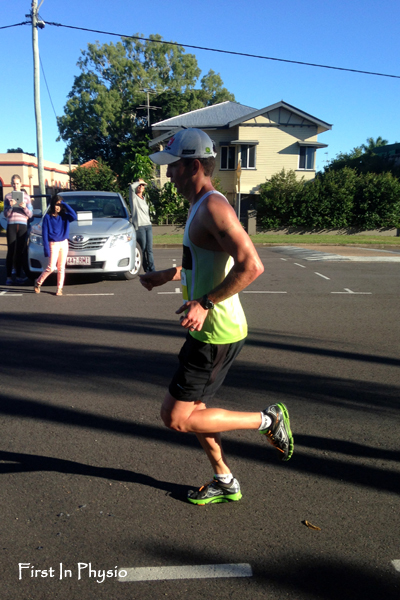While other states are shivering into their hot chocolates, we are lucky enough in the far North of Queensland to be experiencing perfect running weather – beautiful crisp and sunny days with minimal humidity in the air. There is no better time of the year to be upping your running training and looking ahead to one of the many fun runs on offer around the area in the coming months.
Not coincidentally, it is about this time of year that we start to see an influx of running injuries come through our clinic doors. As runners ourselves, we can understand the frustration and stress involved with having to sit out of training or worse, missing your planned race. There are many simple things that runners can do to minimise their injury risk and keep their bodies healthy and minds happy. We’re pretty sure you know all of these , but like most runners, need a simple reminder that you are not “special” – your body is not superman and it does, in fact, need just as much time to adapt to training stimulus as everyone else’s does!
- Training Load
A large proportion of running overuse injuries are caused by simply doing too much, too soon. The classic situation is the runner who has had a few months off, maybe gained a few kilos and not been diligent enough with their strength work, and then decides to do an 8-week training program for an upcoming half marathon or 10km fun run. The first few weeks go by OK with sore muscles and slow shuffling, and then week 3-4 hits and you have shin or foot pain that won’t go away in a hurry…..Sound familiar? While the enthusiasm is great, it is important to “train for the training”. Consider your base level of fitness before jumping feet-first into any training program; if the first week of the training program looks “scary” to you, then you are not ready yet. Running is a wonderful sport for the body but it comes with a high injury risk if you are doing it sporadically. Once you are gradually building up the weekly mileage, give yourself a recovery week once a month, typically reducing the training load to about 60% of your previous week, further giving your body a chance to absorb the training. The healthiest and usually the fastest runners are those who are consistent with their training, year-round, allowing for natural and gradual increases and decreases in their load around race season and off-season.
- Specific Strength Work
Every time you take a step when running, you are literally doing a single-leg squat with up to 4-6 times your body weight going through the chain from your foot up through your knee, hip, pelvis and spine. Think about that. The amount of recreational runners we see come into our clinic who cannot do one quality single-leg squat with one x their body weight – let alone quadruple that amount – is truly scary! Your muscles are very well equipped to take up the excess loads of running so that your joints and bones don’t have to get overloaded; in fact, well-trained muscles will act like springs and propel you forwards with ease and speed. We recommend that all runners do a minimum of 2-3 strength sessions a week, but it must be run-specific ie lots of core, glutes, single leg squat work and lower limb strengthening as well as the all-important balance and flexibility work. A quality session might take you 20-30 minutes, but it will be the best injury prevention investment you can make. An Exercise Physiologist or Physio with an interest in running can help you to design a program that addresses your weaknesses, and most can be done in your own lounge room without fancy equipment.
- Running Technique
If your core and general strength is good, your balance and flexibility and adequate, and you are not excessively overweight, you will have a much easier time achieving optimal running technique. What is “ideal” technique is an often-debated topic amongst the literature, and when it comes down to it, everyone is different and will have a slightly unique “perfect form” that suits their body. Having said that, there are certain key factors that need to be considered to ensure that you are running safely, for both injury management and to increase your speed and efficiency. These include things like high knee lift to utilise the powerful glutes; mid or forefoot strike to optimise the calf muscles as a spring; a leg turnover of about 180 strides per minute (count how many times per minute your right foot hits the ground, then double it); a nice upright torso with a very slight forward torso lean etc etc. If you feel like you aren’t running at your best or you continually get overuse injuries such as shin pain and plantar fasciitis, having a qualified professional assess your running technique could prove to be a worthwhile investment. Coaches, Physios, Podiatrists, and Exercise Physiologists with an interest in running are all qualified to do such an assessment.
Nutrition
Running is a wonderful sport for promoting weight loss and maintaining a healthy body weight. The best runners tend to be the lightest, but that doesn’t mean that you have to look like Paula Radcliffe to enjoy healthy running. If you are more than 5kg above your ideal body weight, be respectful of the extra load on your body as you increase your training load. Also ensure, no matter what your weight, that you fuel well before, during and after your hard run sessions. Optimal nutrition results in faster recovery, better performance and less injuries. Accredited Sports Dieticians are the best people to talk to about fuelling for both running performance and for weight management.
- Shoes
This can be another controversial area that professionals love to debate over. Most qualified health professionals have their opinion on what shoe type is best for you; my advice would be to listen to your body. If you feel like it is hard to run fast, that your shoes are working against you, or that you get a lot of niggles in your current shoes, consider trying something different. I am a fan of the 4mm heel drop shoes and have had great success in them with all of my runners, but as with anything – change needs to be a very gradual thing. If you are used to running in super cushioned, 12mm heel drops and you suddenly swap to a “barefoot” style of running shoes (which I don’t recommend either, unless you weigh 40kg and look like the Kenyan Olympic marathoners), your body will be shocked by the change. You need to allow adequate time to adapt and ensure that you lower your training load and increase your strength work while you change over. I also advise people to have two pairs of runners on the go and to rotate them throughout the week. Most recreational runners doing 40-80km/week will need to change their shoes over every 3-4 months, depending on their weight and the surfaces they train on. This may seem expensive, but when you consider what equipment in some other sports (like cycling) costs, not to mention the cost of a potential injury, it is a relatively cheap investment for foot health!
- Training Surfaces
Try to vary your terrain as much as possible – this is good for load but also a great way of incorporating some strength work and balance (eg. soft surfaces like trail running) into your running. Cement is the highest load for your body to cope with so try to do less than half of your training on it as a general rule.
- Factors outside of Training
This is the one area that runners often neglect. Our training isn’t separate to the rest of our lives, it is included within it. That means if you are tired from lack of sleep, stressed from work or family, or under-fuelled from working through lunch – these things will all impact on your running form and also increase your injury risk. You need to consider how your body feels going into any run – and adjust accordingly. If you are wrecked from work or stress, don’t do that hard track session today; swap it for an easy 5km run and come back stronger for the track session in a few days’ time. I will also add here for the ladies that wearing high heels on fatigued legs is a great way to give yourself a stress fracture – you would be amazed how many times we have seen this in our female athletes! If you must have that big day at the races, at least wear lower heels and stretch calf muscles etc before and after the event.
The number one take-home point is that the body hates rapid change. The human body is an incredible specimen capable of adapting to remarkable training loads: think about what Ultramarathoners and Ultraman (back-to-back Ironman triathlon events) athletes are capable of achieving. They are no different to you or I – they don’t have magical superpowers that allow them to run 100km. They simply dedicated themselves to the process early in their lives and have consistently added training load to allow adaptation in a slow and planned manner. The bottom line is that our body will adapt beautifully to change, if we allow it time to do so. It’s not exciting, but if you ask any long-time marathon runner, it simply works. So if you’re like me and you idolise those crusty 70+ year-old distance runners that line up beside you at races, hoping that one day you too will be still running happily at their age, then take a leaf out of their book: consistency is the key to a long, happy running life.
Happy Training!
– Kristy Shannon B.Appl.Sc(HMS); M.PHTY
Physiotherapist and Exercise Physiologist
REFERENCES
American College of Sports Medicine., American Dietetic Association., Dieticians of Canada. (2009) Nutrition and Athletic Performance: Joint Position Statement. Medicine & Science in Sports & Exercise. 0195-9131/09/4103-0709/0
Barr, K.P., & Harrast, M.A. (2005) Evidence-Based Treatment of Foot and Ankle Injuries in Runners. Phys Med Rehabil Clin N Am 16:779-799
Beck, B.R., Rudolph, K., Matheson, G.O., Bergman, G., Norling, T.L. (2014) Risk Factors for Tibial Stress Injuries: A Case-Control Study Clin J Sports Med 0:1-7.
Buist, I., Bredeweg, S.W., van Mechelen, W., et al (2008) Prevention of Running-Related Injuries Among Novices. Am J Sports Med. 36:33-39.
Van Gent, R.N., Siem, D., van Middelkoop, M. (2007) Incidence and Determinants of Lower Extremity Running Injuries in Long Distance Runners: a Systematic Review. Br J Sports Med 41:469-480.



